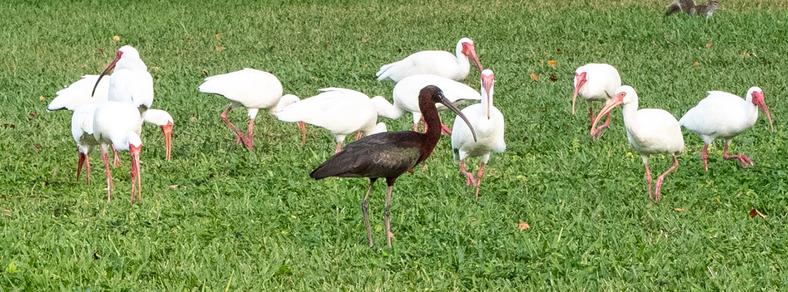At first I thought he was a descendant of a cross with a scarlet ibis, because he was quite pink compared to his mate. Now I think maybe he was hitting the shrimp too hard. #ibis #whiteibis #everglades #swamp #pond #birdphotography #waterbird #naturephotography
Recent searches
Search options
#whiteibis
At first I thought he was a descendant of a cross with a scarlet ibis, because he was quite pink compared to his mate. Now I think maybe he was hitting the shrimp too hard. #ibis #whiteibis #everglades #swamp #pond #birdphotography #waterbird #naturephotography
Young Ibises in Shallow Waters
Two years back, I stumbled upon a pair of juvenile white ibises (Eudocimus albus) at a hidden gem of a pond in Albany, Georgia. Unlike their elegant snowy-white adult counterparts, these young ibises were still in their first-year plumage, which doesn’t turn snowy white until their second year. It was fascinating to watch them amidst the serene waters, showcasing nature's beauty in the making.
"White Ibises are born with brown and white streaks, and as they grow, they gradually develop their adult plumage. Typically, White Ibises start to turn white by the time they are about 9-10 weeks old, although the exact timing can vary. They achieve their striking all-white adult plumage, accented with black-tipped wings, by around 1 year of age." - Copilot
No need to dive underwater for fantastic bird images; just check out my photo gallery:
Immature White Ibis On The Move by Debra Martz
This young one was quite the entertainer as it preened and continually ruffled its feathers. Captured along the 4800 ft boardwalk at South Padre Island, Texas on the last day of February.
https://fineartamerica.com/featured/immature-white-ibis-on-the-move-debra-martz.html
Curved Beak at Dawn
I saw this juvenile white ibis (Eudocimus albus) a couple of years ago in Albany, Georgia.
"White Ibises gather in groups in shallow wetlands and estuaries in the southeastern United States. At each step, their bright red legs move through the water and their curved red bill probes the muddy surface below. As adults, these striking wading birds are all white save for their black wingtips, but watch out for young birds that are brown above and white below. White Ibises nest in colonies in trees and shrubs along the water's edge, changing locations nearly every year" - allaboutbirds.org
Visit my gallery at:
Excited White Ibis by Debra Martz
It was chasing a blue crab & finally caught it. Then the work really began for this Ibis
https://fineartamerica.com/featured/excited-white-ibis-debra-martz.html
Circle Back
Yesterday afternoon, I was sitting outside with my wife in front of her quilting shop, when I noticed a large bird flying over. I was caught, once again, without a camera. But wait! The bird turned and circled back. I ran to the backdoor, almost tripping over Charlie, and fetched my camera. The bird was still around when I got back. It is a white ibis (Eudocimus albus) and it circled around a few times, perhaps to get its bearings then continued on.
You know, the photographs that I post here are not quite a vivid as the same photographs that I post at my pixel's gallery, because here, I reduce the size of the photos and usually make a slight reduction in the quality of the photos to make them easier to load.
Take a look:
https://en.wikipedia.org/wiki/American_white_ibis
#Nature #Bird #Ibis #WhiteIbis #AmericanWhiteIbis #Wildlife
White Ibis and its Reflection
I took this photo in Georgia 2022. It's a young white ibis (Eudocimus albus). It was late and getting dark, but I like the serenity of the picture.
Calm
This is a photo that I took in Geogia almost a year ago. There is a juvenile white ibis and a great egret feeding in a shallow pond.
White Ibis (Eudocimus albus)
These juvenile white ibises flew over this morning while Ben and Charlie took me for a walk. They circled around a couple times as if getting their bearings.
"White Ibises occur in many types of wetlands including swamps, mangroves, flooded pastures, freshwater marshes, and shallow ponds. They forage most often in wet areas with less than 8 inches of water and sparse, short vegetation, but they also forage on lawns and in parks, especially in southern Florida where they are now accustomed to humans. They nest in colonies in trees and shrubs near fresh, brackish, or salt water. During the nesting season, they forage more frequently in freshwater wetlands because nestlings cannot safely consume large amounts of salt. During the nonbreeding season, they use coastal wetlands more frequently." - allaboutbirds.org
White Ibis (Eudocimus albus)
This is a juvinile white ibis, I ran across two of these birds in
georgia. Just a little bit out of their normal range - I think.
"White Ibises gather in groups in shallow wetlands and estuaries in the southeastern United States. At each step, their bright red legs move through the water and their curved red bill probes the muddy surface below. As adults, these striking wading birds are all white save for their black wingtips but watch out for young birds that are brown above and white below. White Ibises nest in colonies in trees and shrubs along the water's edge, changing locations nearly every year." - allaboutbirds.org
A Snowy Egret spent some time making friends at one of the nearby parks
f/10, 1/1000, 300mm, iso400
f/7.1, 1/500, 300mm, iso400
#birding #BirdPhotography #photography #BirdsOfMastodon #SnowyEgret #CattleEgret #WhiteIbis #LaughingGull
Here’s hoping all your landings are gentle ones today.
#photography #fotografia #fotografie #MastoArt #birds #birdsofmastodon #birdphotography #birding #ibis #whiteibis #nature #naturephotography
#LauraCochranPhotography
I know it's here somewhere.
This is a young white ibis that I saw in Georgia last November. There were two of them feeding in a small hidden pond across from our hotel. There were other birds there as well, I went down late one afternoon and took some photographs.
"American white ibises are gregarious birds; however, they are territorial and defend the nesting and display sites against intruders. When threatened or defending a territory American white ibises perform displays that include lunging forward with the bill in a horizontal posture, and standing upright, and snapping the bill opposite another bird engaging in the same display. Birds also lunge and bite, often holding onto an opponent's head or wings". - animalia.bio


